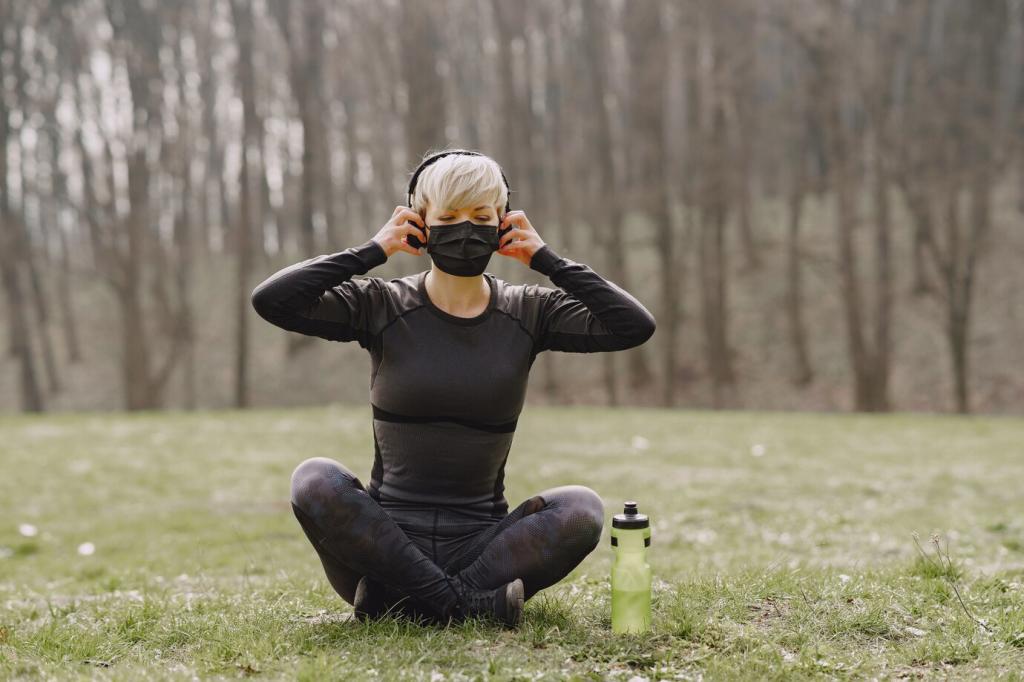
Calm Under Pressure: Reducing Sports Anxiety through Mindfulness
Chosen theme: Reducing Sports Anxiety through Mindfulness. Step onto the field, court, or track with a steadier breath and a clearer mind. We share practical tools, relatable stories, and science-informed insights so you can compete with courage, focus, and joy. Subscribe for weekly drills and tell us how mindfulness shifts your game-day nerves.

Box Breathing Between Plays
Inhale for four, hold for four, exhale for four, hold for four—repeat four times. Use the sideline, baseline, or blocks to visualize each “side” of the box. Athletes say it gives them just enough structure to calm nerves while maintaining alertness for the next play.

The Physiological Reset Sigh
Take a small inhale, then a second, slightly larger inhale, followed by a long, unforced exhale through the mouth. Two or three rounds can ease chest tightness and mental chatter. Try it mid-warmup and after mistakes, then share how quickly your focus returns in the comments.

Pre-Performance Breath Ritual
Create a consistent 60-second breath routine before competition: three slow breaths, one brief pause, and a grounding exhale with a cue word like “steady.” Rituals anchor attention and reduce uncertainty. If you adopt this, tag your routine name below so our community can try it.
Mindful Focus Drills You Can Practice Anywhere
Notice five things you see, four you feel, three you hear, two you smell, one you taste. Speak them internally while breathing evenly. This drill pulls awareness out of worries and into reality, especially in noisy arenas or chaotic sideline moments before a decisive play.
Mindful Self-Talk and Compassion

Name It to Tame It
Label the emotion precisely: “anticipation,” “jitters,” or “fear of mistakes.” Naming reduces intensity by making the feeling a known visitor, not a ruler. Pair the label with a breath and a cue like “present.” Comment the label that best fits your pre-game state this week.

Rewrite the Inner Script
Replace “don’t mess up” with process-centered statements: “eyes on target,” “drive the knee,” “smooth follow-through.” These cues keep attention on controllables and reduce catastrophic thinking. Write three cues on tape or in your notes and revisit them before you compete for reliability.

Compassion After Mistakes
Treat errors as data: note what happened, breathe, and choose one actionable adjustment. A high school sprinter shared that saying, “Good try, adjust foot strike,” helped her rebound faster than harsh self-criticism. Share your best compassionate reset so teammates here can borrow it.
Visualization and Mental Rehearsal with Presence
Process Over Outcome Imagery
Picture your setup, breath, and first movement—not the medal, crowd, or scoreboard. See your cues unfolding smoothly, step by step. This shifts attention from uncontrollable results to repeatable actions. After trying it, share whether your pre-competition nerves felt lighter or more organized.
Multi-Sensory Scenes for Realism
Add sound, temperature, textures, and smells to your mental rehearsal. Hear the whistle, feel the tape on your fingers, notice the floor’s grip. The brain responds to detail with stronger learning. Post your favorite sensory anchor, and we’ll compile a community list of ideas.
Coping Imagery for Adversity
Imagine a stumble, early foul, or slow start—and watch your calm response. See yourself breathe, refocus, and apply one cue to re-engage. Anticipating difficulty reduces shock when it appears. Comment a challenge you rehearsed and how it changed your reaction on game day.
Building a Mindful Team Culture
Start practice with two silent minutes: one to breathe, one to set intentions. Coaches can model stillness by joining. Athletes often report smoother transitions and fewer frantic mistakes afterward. Try it for a week and share whether communication and focus improved during drills.
Invite captains to ask, “Green, yellow, or red?” for readiness. No explanations required. Pair colors with one mindful breath and a cue word. This normalizes emotions and gives teammates a shared language for support. Tell us how your team adapted the scale to your sport.
Create a list of process cues on a whiteboard or group chat—short, actionable, and sport-specific. Rotate featured cues each week. When nerves spike, teammates can borrow a phrase that works. Post your top three cues so other readers can expand their own libraries.


Body Scan for Tension Release
Lie down, close your eyes, and sweep attention from toes to head. When you find tension, soften it on a long exhale. Just five minutes can downshift your system. If you enjoy it, set a nightly reminder and share your favorite guided track or self-led script.
Evening Wind-Down Ritual
Choose a consistent 20-minute pre-sleep routine: dim lights, light stretching, three slow breaths, and no screens. Mindfulness here signals safety, making it easier to drift off. Report your routine components, and we’ll feature a reader-designed wind-down in next week’s newsletter.
Micro-Mindfulness During the Day
Insert 30-second mindful pauses between activities: after tying shoes, before opening messages, or stepping onto the court. Small repetitions build a reflex for calm attention. Track how many you complete today, and challenge a friend to join. Tell us what cue reminded you most.
